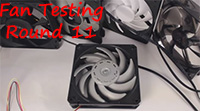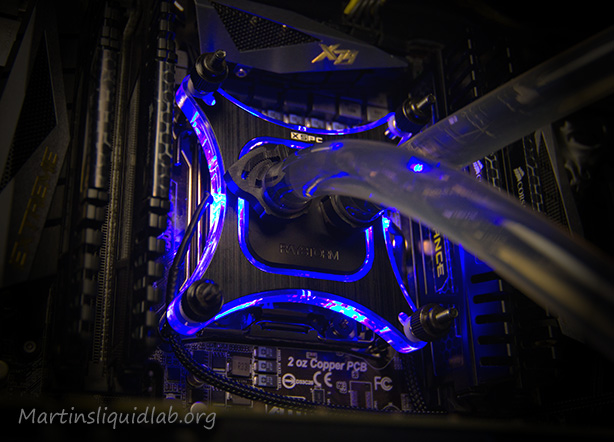Welcome to round 12 fan testing:
A huge thanks goes out to cpachris and Prymus of OCN for sponsoring the fan samples!
Intro
Gentle Typhoon AP-15 1800RPM
Gentle Typhoon AP-45 2150RPM
Noctua NF-F12 1500RPM
Noiseblocker E-Loop B12-3 1900RPM
Akasa Piranha
Corsair SP120 High Performance 2350RPM
Cougar Dual-X Red LED CF-D12HB-R 1200RPM
Noiseblocker E-Loop 2400RPM B12-4
Cougar Vortex PWM CF-V12HP 800-1500RPM
Cougar Vortex HDB CF-V12H 1200RPM
Under construction…Videos are now uploaded, but I have not extracted any chart data.
Doing a quick video review I find the following
@400FPM air flow levels
- The two GT fans have the lowest noise level (Around 38dBA)but do have a slight whine noise quality.
- The two Noiseblocker e-loops have the second best noise level at around 43dbA and slightly better noise quality (more air noise and less bearing whine)
- The Corsair SP120 has the third lowest noise level at around 44-45dbA but does have a little bit more motor noise.
- The three Cougar fans get fourth in noise level with a varied noise quality. The PWM flavor does exhibit more noise using voltage control than the HDB model. The Dual-X and Vortex HDB are pretty close. The Piranha fan is a similar noise level an quality at around 46 or so dBA, fairly smooth but not silky smooth either.
- The loudest fan at 400FPM is the Noctua NF-F12 at around 48dBA
@500FPM air flow levels
- The two GT fans continue to have the lowest noise level at 42-43dbA, but it is a different tone (very little air noise, mostly just a bearing sound). Interestingly the AP-45 sample seems a bit smoother here than the AP-15
- The Corsair SP120 is second lowest at this performance level at about 49dBA, noise quality is ok but not ultra smooth either.
- The Noiseblocker B12-3 1900RPM model may not have super low noise level at 50dBA, but by ear it actually sounds much better. It is a smoother sound quality and makes it seem like a good number and actually comparatively good as the GTs. Also interestingly the noise quality of the higher speed Noiseblocker e-loop 2400RPM doesn’t seem nearly as good as the 1900RPM slower speed brother at this performance level.
- The Cougar Vortex PWM is the only one to make it this far of the Cougars and putting out around 52dBA however noise quality is rather poor with a stronger motor tick.
- The Noctua and Piranha also have legs to get to this air flow level, but the noise is also higher in the 52-53dBA levels and the noise quality not very good. The Piranha also seems to have a slight motor tick at this speed.
@600FPM air flow levels
- The two GT fans continue to have legs to get to this point and at their trademark low noise levels although not what I would call great noise quality. There is a rather dominating bearing noise without much air noise to mask it. Regardless, it is hard to argue with the low 46dBA noise level at these speeds.
- The Corsair SP120 would take second lowest noise level at this point with about 54dBA. It is considerably higher than the GTs, but still seems to be in it’s game without any unusual noise quality issues, fairly smooth for the speed.
- The B12-4 higher speed Noiseblocker E-loop also makes it this far, but noise quality dramatically reduces with a higher whine developing. Noise level is a similar 54dBA, but it sounds louder than that by ear.
- The Piranha also has legs to get here, but it’s the loudest of the bunch at 58dBA and also has some noise quality issues with an undulating low frequency and some motor tick.
- The Noctua and Cougar fans are not capable of this much air flow.
@700FPM air flow levels
- Only the GT AP-45 2150 model is capable of getting here and continues it low noise crown at only 49dBA but noise quality is continuing to suffer a little bit with a more pronounced whine.
- Only the Noiseblocker e-loop 2450 model can make it here, but at the cost of a higher noise level 58dBA and noise quality is also poor, just flat getting loud at this point.
- All other fans are not capable of getting this far.
King of “MOST AIR THROUGH THE RADIATOR”
That would be a tie between the Gentle Typhoon AP-45 (2150) and the Noiseblocker E-loop B12-4 (2400RPM) model. I measure roughly 72hz(2160RPM) from the GT and about 77hz(2310RPM) coming from the NB. So despite the RPM advantage the GT is still producing the same air flow through the radiator which is a tribute to it’s very pronounced and curved PQ curve.
King of “BEST NOISE LEVEL/AIR FLOW THROUGH A RADIATOR”
The Gentle Typhoons retain their crown on this criteria and really shine at very high speeds, but that differentiation does drop off as speed decrease. The Noiseblockers e-loops also have an interesting noise quality and perform really well at speeds below about 1500RPM. At the 400FPM and 500FPM performance levels by ear I have a hard time telling the difference between the GTs and the Noiseblocker B12-3. The smoother noise quality of the Noiseblocker almost seems to make up the different in noise level. The Corsair SP120 also does fairly well on noise level and consistently so throughout it’s speed range, it’s just not as smooth in noise quality as the NBs are at slower speeds, but it does hold it’s up at higher speeds. None are even close to the GTs at really high speeds though where the GTs have upwards of a 10dbA noise level advantage.
BEST FAN 300FPM (~1000 RPM)
At this point I would call all the fans relatively the same. The Cougars, Noiseblocker, Noctua, GTs, Piranha, are all performing in that 36-39dBA and subjectively hard to tell much difference. This and slower speeds is where it just doesn’t make sense to spend a ton of money on fans. Cheaper value fans perform just as well as the expensive ones and the Gentle Typhoons also don’t really separate themselves much. I actually prefer the sleeved and HDB bearing type fans a little better in noise quality at these slower speeds. I would probably call it a tie between the Noiseblocker B12-3, Noctua NF-F12, and Cougar HDB as they seem to have a slightly smoother sound quality at these slower speeds.
BEST FAN 400FPM & 500FPM (<1500 RPM)
This is where it gets kind of interesting to me. I kind of like the Noiseblocker e-loop B12-3 at these points although the GTs are good too and do have a slight noise level advantage. I just like the smoother sound quality of the noise blocker better and I also prefer the looks of the NB fan better. I’m going to call it a tie between the GTs and the Noise blocker E-loop B12-3.
BEST FAN 600FPM & 700FPM (>1500 RPM)
While the noise blocker is really nice at slower speeds, the Gentle Typhoon rules the high speed area. I wouldn’t call either one silent or perfect in noise quality, they do produce a different tone which seems slightly more whiny with bearing noise than others, but the noise level is remarkably low in comparison. The Corsair SP120 is actually not too bad at higher speeds as well, but it does have a slightly lower maximum where the GT AP-45 is doing just a bit better.
Overall. I was a bit surprised by the Noiseblocker e-loop B12-3 at the mid speed range, very good noise quality makes them competitive with the GTs. The cougar fans seem to do well at very slow speeds, but they are a bit limited in higher speeds and didn’t do as well as I hope based on forum comments. The Noctua NF-F12s do well at very slow speeds, but very poor at the higher speed relative to the forum comments. I don’t understand why they are so often so highly recommended except I know of a few reviews done out there without proper tools that are likely spreading bad information as usual. The corsair SP120 fan also surprised me a bit. It did seem to do a little better in noise quality than the H100i fans, but it’s not as strong a performer in noise level as many forum recommendations seem to convey.
As always, I would highly encourage you to “Listen” to the videos and be your own judge. It is very clear to me that the noise level showing in the meter is not at all the full story. You really need to listen to the audio in the videos and match up air flow numbers to gain a good perspective. I would also caution that this “Air Flow” comparison is also just approximate. Comparing thermally would be more accurate, but I know from radiator testing that to do rad thermals accurate, you are looking at a 1 hour test per data point. I was able to capture upwards of 10 air flow data points per fan in about 10 minutes of flow bench testing. It took me about 2-3 hours of video recording followed by another 4-5 hours of processing/uploading. Trying to capture 10 data points per fan over 10 fans thermally would have literally taken 100 hours or more, and yes I’m too lazy for that. This is the best I’m willing to do and as always, it is just one test. I would encourage you to take it as such and utilize other resources to gain additional perspectives and test data.
My one and only suggestion about other testing is to look carefully at how they measure noise and performance. If noise is not measured while the fan is mounted to either a radiator or a heatsink, then the data is pretty much useless. Noise MUST be measured when mounted in the used condition.
Thanks for looking!
Martin













